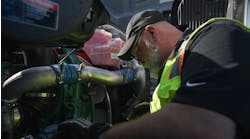For fleets facing facility investment issues, strained technician resources and higher fleet maintenance costs due to varying quality from multiple suppliers, WheelTime Fleet Services (WFS), a repair and preventative maintenance program from WheelTime Network, has become a viable and effective solution.
"When we launched it last year, our goal was to be able to offer a total spectrum of preventive and repair services necessary to lower total costs. Today, WheelTime Fleet Services gives smaller fleets access to data, information and analytics never seen before," said Mike Delaney, president and CEO of WheelTime. "Results show the benefits of preventative maintenance and detailed reporting which allows fleets to take a more active role in making sure their vehicles don’t go down."
Driven by WheelTime’s commitment to two-hour initial diagnosis, service quality and consistency across its network, over the last decade, WheelTime’s 18 members invested more than $13 million into information technology, technician training and program development to take total vehicle care to new levels. As a result, the WheelTime Fleet Services program is showing fleets significant increases in vehicle productivity, reduced fleet downtime and decreased cost in both planned and unplanned repairs.
WheelTime Fleet Services integrates online billing and estimating along with historic data on each asset and fleet specific maintenance protocols to achieve agreed upon goals of service speed, consistency and accuracy. WheelTime Fleet Services customers are seeing value from the program, including:
1. WFS electronic service management platform interfaces with both the service provider and customer.
a. Seamless event management with electronic communication.
b. Telematics feeds for the update of engine miles/hours.
c. Standardized maintenance and labor operations specific to the customer’s requirements.
d. Expedited work estimate/customer authorization process to speed up the repair process.
e. VMRS coding of operations to assist in measuring vehicle performance and the identification of root causes of failures.
f. Electronic historical service and repair documentation by unit which aids in more effective asset management – better control of life cycle costs and optimization of asset profitability. Historical records also assist future spec’ing.
2. WFS information and data collection gives the customer control:
a. Better informed disposal decisions along with cost justification to purchase new equipment.
b. Enhanced cash flow management through improved balance sheet management and informed fleet aging purchase decisions.
c. Reporting that measures vehicle cost by unit or mile, days out of service and overall fleet health (i.e. PM currency).
The WheelTime Network continually investigates new ways to measure and perform services. To date, it has collected quality metrics on over 1.7 million repair orders and followed up with over 50,000 customer interviews to better understand how to make service better.
WheelTime also identified that about half of the estimated $63 billion truck parts and service market is preventative maintenance. In spite of significant fleet investments, however, more than 70 percent of the trucks and busses coming into member shops needed more than just the repairs requested. "Where were the preventive maintenance dollars going?" asked Delaney.
"We began catching other problems and taking care of them when the vehicles were going to be down anyway," said Delaney. "The customers loved it. By 'compressing' multiple maintenance events into a single visit, we reduced total time out of service. Many repairs we saw, however, could have been easily avoided or reduced through better preventative maintenance practices in the first place."
"Also critical today is CSA compliance and, maybe not surprisingly, the most common repairs needed are DOT related," he added. "Inconsistent preventative maintenance practices along with inadequate record keeping and systems that don’t talk to each other don’t just make it hard to stay on top of things, it can shut fleets down."
Critical to the development of WheelTime Fleet Services was the development and installation of WheelTime LINQ, the Network’s innovative service management platform. LINQ contains a number of service enhancing capabilities. With the same system in use at many locations, LINQ feeds data from work performed anywhere into the same central data base. On-site work and in-shop repairs across the Network can be combined to create the vehicle’s complete maintenance records, and detailed records provide advanced data for analysis and continuous improvement in cost control for the fleet.
"We’re in about 80 percent of locations with LINQ now," said Delaney. "Our goal is complete coverage by the end of 2014."
LINQ controls costs up front by ensuring quotes and work conforms to pre-agreed time standards. This ensures quality, eliminates surprises and speeds up the administrative processes surrounding the repair. Quotes can become nearly instantaneous. With the emphasis on detailed, upfront estimates, lengthy approvals are cut to minutes and disputes are virtually eliminated.
"Since we are standardizing on a common set of systems and capabilities, we can easily link the quote process to a centralized billing and terms verification process - on both parts and labor," said Delaney. "That gives us an unmatched capability to manage customer costs before, during and after the repair."
For fleets with challenges at many locations, WheelTime can roll up reporting to provide a clear picture of local, regional and national costs and trends.
"Efficiency and speed, guided by advanced systems and administered by a high quality truck and coach service network, offer breakthrough capabilities for customers to reduce costs, increase control and drive 'wheel time'," Delaney added. "Our overall goal remains, as the name implies, to reduce time in the shop and create more time at the wheel for every customer."


